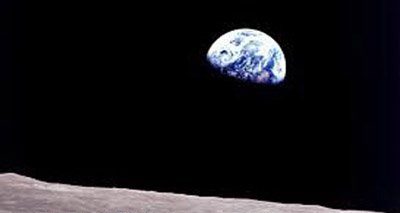
Astronaut Bill Anders's classic 'Earthrise' photo | Courtesy of NASA
As Ebenezer Scrooge found, Christmas Eve is a fitting time to reflect on the past, consider the present, and glance into the future. Scrooge wasn’t thinking about space flight, though when he asked the ghost of his deceased partner, Marley, if he traveled fast, the reply was “On the wings of the wind.” To put this into context, the highest non-tornado wind speed ever recorded on Earth is 253 miles per hour, so for Scrooge’s time in Victorian England, this truly was fast. Compared to planes and rockets in the modern era of flight, however, it lags way behind. The cruising speed of a Boeing 747, for instance, is 550 miles per hour. Then there’s the International Space Station, which travels a bit more than 17,000 miles per hour while orbiting Earth.
A half century ago, the Apollo 8 spacecraft had to exceed speeds of 25,000 miles per hour in order to escape the pull of Earth’s gravity and head toward the Moon. Precisely 50 years ago today—December 24, 1968—Apollo 8 arrived at the Moon and orbited 10 times. It was on this flight that astronaut Bill Anders captured one of the most compelling and influential pictures of all time, showing our home planet Earth against the backdrop of space. At that moment, Anders and his crewmates Frank Borman and Jim Lovell could look at the sum of all of humanity; that little ball was home to all 100 billion Homo sapiens—and their ancestors (unless we consider that our ancestors were aliens)—who have ever lived.
Today—as in December 24, 2018—Alan Stern and his legion of engineers and scientists, including Lowell Observatory’s Will Grundy, are riding the wings of New Horizons on their quest to unravel the mysteries of outer space. To be clear, the New Horizons spacecraft doesn’t actually have wings, which would be useless in airless outer space. In any event, this is the fastest moving craft in history, speeding to (486958) 2014 MU69, a Kuiper belt object that the New Horizons team thankfully nicknamed Ultima Thule, at a speed of more than 31,000 miles per hour.
Stern and company, as well as a multitude of space enthusiasts around the world, anxiously look forward to next week, when New Horizons arrives at, and quickly passes, Ultima Thule. Expected flyby time is January 1, 12:33 a.m. at mission control in Maryland, 10:33 p.m. on December 31 in Flagstaff. New Horizons has quite a track record, with its 2015 flyby of Pluto unveiling a world far more dynamic and exciting than most people imagined. What New Horizons show of Ultima Thule? Stay tuned – we are about to find out!